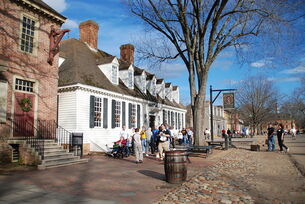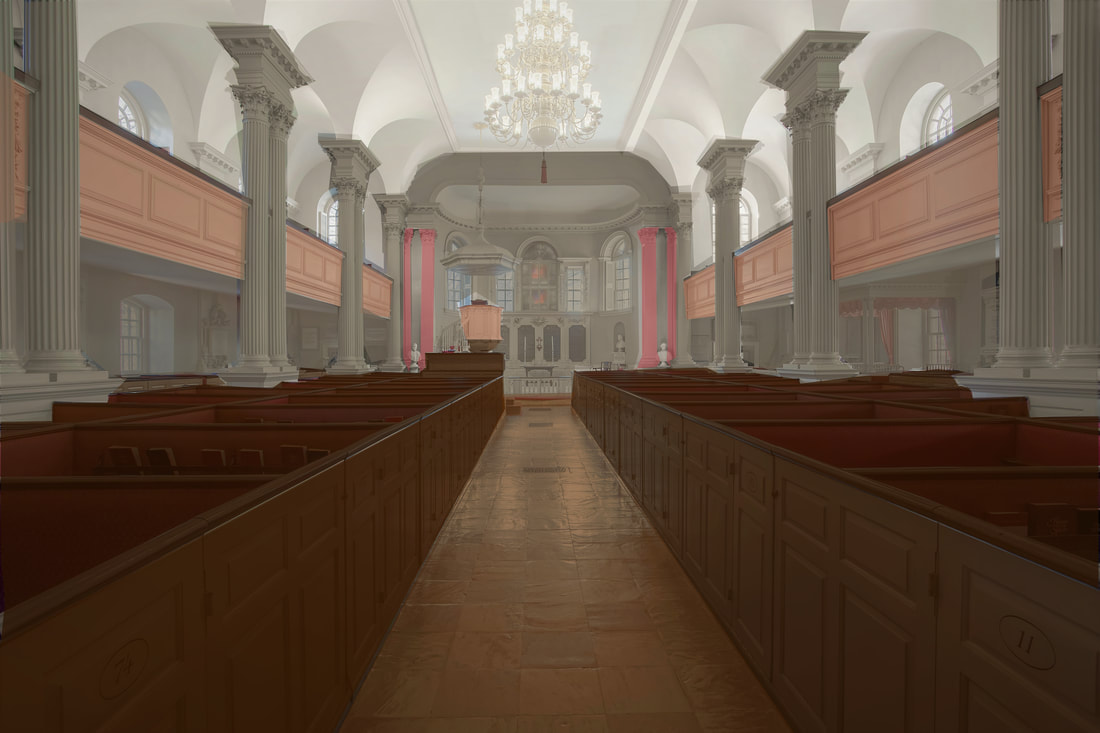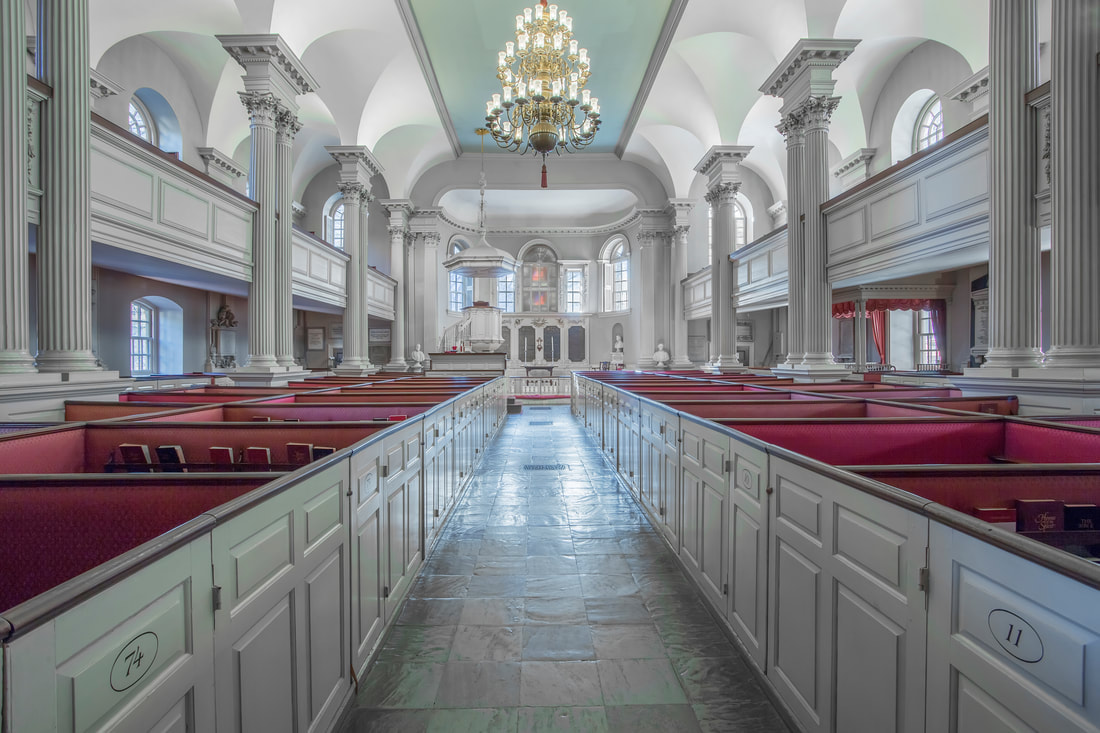|
By Lily Nunno, Historic Site Educator From 1915 and into the early 1920s the interior of King’s Chapel went through a series of changes: the walls were repainted, new floors were put in, the pews were reupholstered, and the stained glass windows were removed. Like many other buildings in Boston and around the United States, the King’s Chapel interior was reimagined to reflect the Colonial Revival aesthetic. This often involved stripping away any Victorian decoration — like floral motifs— and replacing it with a cleaner and simpler look. This renewed interest in the aesthetics of the 18th century initially began with the Centennial celebration in 1876, similar to the fervor during the Bicentennial. This led to an increased desire to preserve colonial buildings and the homes of historical figures. The idea of historic preservation we are familiar with today was fairly new in the late 18th century. In previous decades, historical buildings — like the home of John Hancock in Boston — were torn down. However, these efforts were not necessarily historically accurate. Pale colors were used when reimagining interiors in the Colonial Revival style, though colonial interiors were often colorful. For example, the pilasters at King’s Chapel were faux pink marble and galley fronts were peach during the 18th century, but during the Colonial Revival redesign the interior of the church was whitewashed. This inaccurate view of the Colonial period extended beyond architecture and interior design. As the United States underwent changes, many white, upper-class, and Protestant Americans yearned for a past they saw as superior to their present. The fascination with the Colonial period originating during the Centennial was primarily fueled by patriotism. The United States was recovering from the trauma of the Civil War; this created a desire for a unifying historical narrative and distinctly American culture. So many turned to the Colonial past to fulfill this desire. As cities expanded and agriculture was overtaken by industry, nostalgia for the more pastoral image of Colonial America grew. Colonists’ lives were seen as simpler and innocent, ignoring the harsh realities of disease, armed conflicts, settler colonialism, and struggle against the elements that plagued early American life. The Colonial Revival was also a response to the increase in immigration the United States saw in the late 19th century and early 20th century. Newly-formed lineage organizations such as The Daughters and Sons of the Revolution hosted Colonial themed pageants and parades for immigrants. These were intended to educate immigrants on American culture and history to help them assimilate. Though these organizations may have had good intentions, these events portrayed a singular idea of what it meant to be American. For other Americans, connecting to the Colonial past became an expression of xenophobia. Middle-class families showed off their Colonial heirlooms in order to prove their ‘superior’ heritage and separate themselves from new arrivals to America.  Colonial Williamsburg, Virginia Colonial Williamsburg, Virginia This distancing from Europe was also present in architecture, with many American architects praising the New England Colonial style as the true American form of architecture. There was also debate about how ‘American’ Colonial period architecture really was and how heavily it was influenced by English architecture. Those who decided to build homes in Italian and French styles were met with criticism, and public buildings increasingly reflected Federal and Georgian architecture styles popular in the 18th century. This sentiment increased around the First World War as isolationist and nationalist attitudes extended beyond politics. Colonial Williamsburg is a famous example of this focus on Colonial architecture and nostalgia. The now-famed outdoor museum was built to honor America’s Colonial past and architecture. For Colonial Williamsburg’s creator W.A.R Goodwin and primary financier J.D. Rockefeller, the museum represented an “idyllic American past.” In the early 1920s, hundreds of more recent buildings were demolished in order to build Colonial-style buildings, while other buildings were often stripped of any post-18th-century renovations. This practice would be frowned upon by those working in historical preservation today. Veneration for the Colonial period continued past this period, during Boston’s Big Dig post-18th-century artifacts, were deemed not worth preserving, leading to the destruction of 19th-century artifacts. The Colonial Revival phenomenon of the late 19th and early 20th century preserved or renovated many buildings and homes still enjoyed by the public today, including King’s Chapel. It was an important step towards the practices of historical preservation that exist today. But this movement also at times reflected a nationalist viewpoint and a rose-colored view of Colonial America. This feeling of nostalgia was based on an inaccurate perception that the past was better and simpler than the Present. America has experienced over the past twenty years, a period of both societal trauma and social change. This has led some Americans to see the past, primarily the mid-20th century, as better than our present. President Trump along with other politicians and public figures have played on this trend and have promised to make America great once again. This appeal to the past is utilizing the same nostalgia and nationalism that was present during the Colonial Revival, down to the rejection of immigration. While there is nothing wrong with looking to the past to learn, explore, and preserve it is important to be wary of the veneration and simplification of the past. Sources:
Barry, K.M., “Buildings as Artifacts: Heritage, Patriotism, and the Constructed Landscape.” Architectural Histories, 5(1), (2017): p.3. Historic Structures Report for Kings Chapel in Boston. Good Clancy. 2006. Kim, Jihong, and Bong Hee Jeon “Restoration of a Historic Town to Commemorate National Identity: Colonial Williamsburg in the Early Twentieth Century”, Journal of Asian Architecture and Building Engineering,11:2, (2012): 245-251. May, Bridget, Fiona Fisher, Patricia Lara-Betancourt, Trevor Keeble, and Brenda Martin. "Wearing and Inhabiting the Past: Promoting the Colonial Revival in Late-nineteenth- and Early-twentieth-century America." In Performance, Fashion and The Modern Interior: From the Victorians to Today, (2011): 58-45. Rhoads, William B. "The Colonial Revival and American Nationalism." Journal of the Society of Architectural Historians 35, no. 4 (1976): 239-54.
1 Comment
|
King's Chapel History ProgramDive deeper into King's Chapel's 337 year history on the History Program blog. Archives
July 2023
Categories
All
|


 RSS Feed
RSS Feed